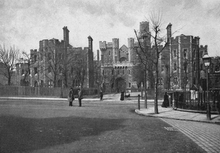Holloway Prison
Her Majesty's Prison Holloway ( HMP Holloway ) was a women's prison on Parkhurst Road in the Holloway borough of Islington, northern London .
history
The castle-like original building of the prison was built to a design by the architect James Bunstone Bunning (1802–1863); the six wings were arranged according to the panopticon principle . The prison opened in 1852 as the City Prison for Men, Women and Young People , but was converted to an all-women prison around 1902 due to the growing need for prison places for female prisoners .
The prisoners also included suffragettes such as Charlotte Despard , Constance Markievicz , Hanna Sheehy-Skeffington , Ethel Smyth and the sisters Frances and Margaret McPhun . During the Second World War, the fascist party leader Oswald Mosley and his wife Diana spent some time as internees in a house on the premises of the prison. Five executions took place in Holloway during the 20th century, including those of Edith Thompson (1923) and Ruth Ellis (1955).
From 1971 to 1985 the prison was completely rebuilt and could then accommodate up to 495 prisoners. In 2016 Holloway Prison was closed.
Holloway Prison as a motif of popular culture
The British band Bush released the song Personal Holloway about prison on their album Razorblade Suitcase , the band Marillion released the song Holloway Girl on the album Seasons End . The British band The Kinks describes in their song Holloway Jail on their album Muswell Hillbillies the life of a young woman who is incarcerated in Holloway. A character from the movie Cube is named after the prison.
Web links
- Holloway Prison , justice.gov.uk (English)
- Article on executions in Holloway (English)
Coordinates: 51 ° 33 ′ 12 ″ N , 0 ° 7 ′ 29 ″ W.
Individual evidence
- ^ EE Reynolds, NH Brasher: Britain in the Twentieth Century . Cambridge University Press, Cambridge 1966, pp. 37 .
